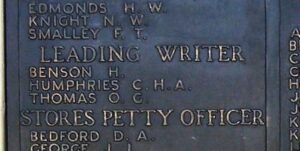Llandyssul is situated on the Carmarthenshire and Cardiganshire Border. The War Memorial is inside Eglwys Sant Tysul, and remembers men who gave their lives in both World Wars. These men are remembered below. Any men who had ties with the area are also remembered here and are marked if they are not on the War Memorials. Many thanks to Huw Davies for the photograph of the memorial.
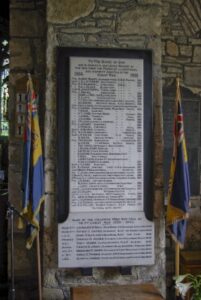
The Great War, 1914-1918
Albert Bailey, Private, R/2296, Kings Royal Rifle Corps. Albert was the son of Joseph and Mary Ann Bailey, of Manchester. He worked as a Printer and Compositor at Llandyssul prior to the war and enlisted at Warrington into the 10th Battalion, King’s Royal Rifle Corps, which was attached to 59 Brigade, 20th (Light) Division. The Division moved to France during July 1915 and assembled at St. Omer, before moving to positions near Fleurbaix. When the Battle of Loos was launched on 25 September 1915, the Division fought a diversionary attack towards Fromelles. Later that year they moved north, and fought at the Battle of Mount Sorrel alongside the Canadian Corps. Over the winter of 1915/16, the Division remained in positions south of Ypres. Albert was killed in action on 29 February 1916, whilst the Division were in positions at Ypres. He was 23 years old, and is buried at La Belle Alliance Cemetery, Belgium.
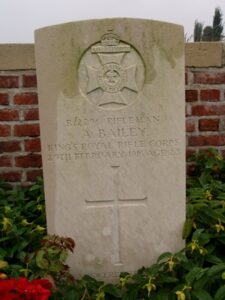
Herbert Henry Bardwell, Private, 35401, South Wales Borderers. Herbert was born in Stratford, Essex, probably the son of John and Ann Bardwell, of 22, Giraud Street, Poplar. He had moved to Llandyssul prior to the war, working for the James family at Corsyfran. He enlisted at Lampeter into the 12th Battalion, South Wales Borderers, which was attached to 119 Brigade, 40th (Bantam) Division. The Division moved to France in June 1916 and took over positions in the line near Loos, where they remained until moving to the Somme later that year, where they fought at the Battle of the Ancre. They spent their first winter in the trenches of 1916/17 on the Somme, and followed the German withdrawal to the Hindenburg Line in March 1917. They remained in the area for the rest of the year, which is where Herbert was killed in action on 6 May 1917, aged 20. His body was never found, and so he is remembered on the Thiepval Memorial, France.
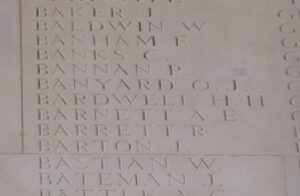
Victor Arthur John Blake, Private, 29117, South Wales Borderers. Victor was the son of Arthur and Alice Blake, of 23, St. Alphonsus Road, Clapham, London, and the Husband of Ada May Blake. They lived at Blaenpant, Llandyssul prior to the war, and Victor enlisted at Brecon into the 2nd Battalion, South Wales Borderers. At the outbreak of war the Battalion were on garrison duty in China. They fought an action here against German troops stationed on Tsingtao, before being rushed back to England, where they joined 87 Brigade, 29th Division, and moved to Gallipoli via Egypt, landing on 25 April 1915. They remained here until evacuation to Egypt on 11 January 1916 and then moved to the Western Front on 15 March, taking up positions at Beaumont Hamel. The Division took part in its first major action in France during the 1916 Somme Offensive, and fought at the Battles of Albert and Le Transloy, suffering heavy casualties. In the Spring of 1917 they fought at the Battle of the Scarpe, which was part of the Arras Offensive, and then moved further north to Ypres. Here they fought at the Battle of Langemarck, which is where Victor was killed in action on 16 August 1917. He was just 20 years old, and is remembered on the Tyne Cot Memorial, Belgium.
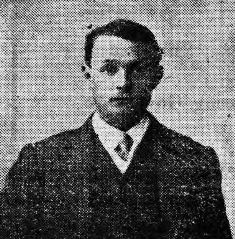
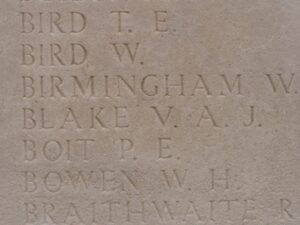
Francis Burge, Private, 10180, King’s Own (Royal Lancaster Regiment). Francis was born at Llandyssul. He resided at Lancaster prior to the war, and enlisted there into the 1st Battalion, Kings Own, which was attached to 12 Brigade, 4th Division, landing at Boulougne on 23 August 1914. They fought at Le Cateau, and then took part in the epic retreat to the Marne, where the German Offensive was halted, and in the advance to the Aisne. The Division was then moved north to Flanders, and took part in the Battle of Messines, where Units of 4th Division took part in the famous Christmas Truce while they were still in this area, in trenches near Ploegsteert Wood. In 1915 the Division fought at the Second Battle of Ypres, and in the summer of 1916 were on the Somme, where they fought at the Battle of Albert and the Battle of Le Transloy. Francis was killed on the Somme on 30 July 1916. For some strange reason he is commemorated on the Ypres (Menin Gate) Memorial, Belgium. Francis is not commemorated at Llandyssul.
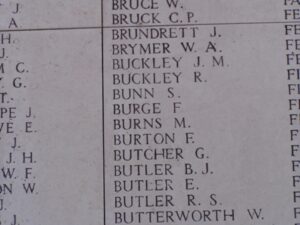
Stanley Teifi Church, Private, 23905, Welsh Regiment. Stanley was born in Llandyssul on 12 December 1897, the son of Edward and Martha Church. By 1901 the family had moved back to their native Cardiff, and lived at 59, Mynachy Road, Cardiff. Stanley worked for the Cardiff Railway Company prior to the war, and enlisted at Cardiff into the 16th Battalion, Welsh Regiment (Cardiff City). The battalion trained at Rhyl before moving to Winchester with 115 Brigade, 38th (Welsh) Division, and landed in France on 4 December 1915, moving to the Fleurbaix sector, where it was initiated into trench warfare. During June 1916 the Division marched south to the Somme, and on 7 July 1916 115 Brigade attacked Mametz Wood. Stanley was killed in action during the futile assault across No Man’s Land on 7 July 1916, aged 18. He is buried in Flatiron Copse Cemetery, Mametz, France. Stanley does not appear to be commemorated locally.
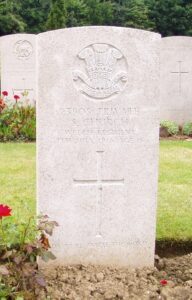
Thomas Collier, Private, 18550, East Lancashire Regiment. Thomas was born at Folkestone, and resided at Cwmeinon, Llandyssul prior to the war. He enlisted at Llandyssul into the Welsh Regiment, and later transferred into the 6th Battalion, East Lancashire Regiment. The Battalion was attached to 38 Brigade, 13th (Western) Division. On 16 June 1915 the Battalion left Avonmouth for Alexandria, and on 7 July 1915 landed at Cape Helles, Gallipoli. They moved to ANZAC Cove on 3 August, and fought there in the Battle of Sari Bair. Thomas was killed in action at Sari Bair on 9 August 1915. He has no known grave, and so is remembered on the Helles Memorial, Gallipoli.
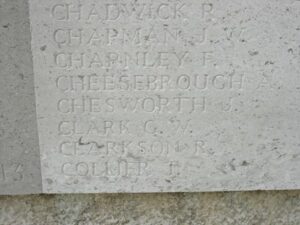
Benjamin Jones Davies, Captain, South Wales Borderers. Benjamin was the son of Griffith and Catherine Margaret Davies, of The Lodge, Llandyssul. Benjamin was educated at Llandovery 1900 from 1905, and after leaving Llandovery, entered St. David’s College, Lampeter, where he became Senior Scholar and graduated B.A. In 1912 Benjamin was a cadet in the Oxford University O.T.C., and in the July of that year was listed as a 2nd Lieutenant, in Reserve of Officers O.T.C. In August 1914, Benjamin Davies joined the University and Public Schools Battalion, Royal Fusiliers, and on the 7th August 1914 was commissioned into the 3rd Battalion, South Wales Borderers. On 12 March 1915 Benjamin embarked for France, and on 1 May 1915, was promoted to Captain. In September 1915, Benjamin was posted to the 2nd Battalion, S.W.B, serving at Gallipoli attached to 87 Brigade, 29th Division. He arrived at Gallipoli on 6 September 1915, and his new Battalion moved to Imbros on 22 September. However, Benjamin’s stay with the Battalion was short lived as he fell ill, and on 28 September 1915 he was in hospital at Alexandria. In February 1916, Benjamin had recovered, and rejoined the Battalion. In March 1916 the Battalion was posted to France, sailing to Marseilles. On its arrival in France, the Battalion went into training at Domart. On 1 July 1916 the Battalion went into action at Beaumont Hamel, on the first day of the Battle of the Somme, and were decimated. Benjamin, along with a Lieutenant Ross, organised the survivors of the attack into two Companies, taking over 300 yards of front line trenches near Mary Redan. The Division then moved for a short period to the Ypres Salient, prior to returning to the Somme Front in October 1916, moving to positions at Grease trench near Gueudecourt, enduring freezing conditions. Here Benjamin was wounded. In April 1917 he rejoined his Battalion at Monchy-Le-Preux, near Arras. On 19 May 1917, Benjamin was killed in action when his Company came under heavy enemy machine gun fire. The Battalion records state that he “led an advance with the utmost courage”. Benjamin was 31 years old, and as he has no known grave, is commemorated on the Arras Memorial, France.
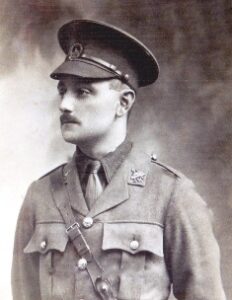
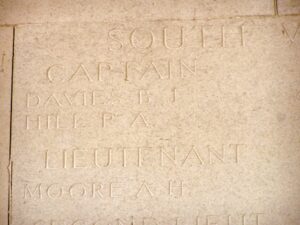
David Davies, Private, 15858, Welsh Regiment. David was born in Llandyssul. He had moved to Llwynypia before the war, and enlisted at Tonypandy into the 9th Battalion, Welsh Regiment. The Battalion were attached to 58 Brigade, 19th (Western) Division. Divisional training was completed near Tidworth, from March 1915, and the Division crossed to France during July 1915, and moved to positions north of Loos. The Division saw their first major action at the Battle of Loos, where David was killed in action on 25 September 1915. David is buried in Brown’s Road Military Cemetery, Festubert, France.
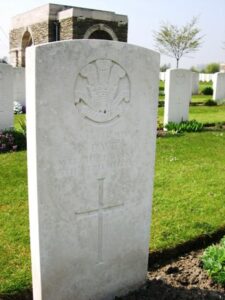
David Dale Davies, Private, M/409373, Royal Army Service Corps. David was the son of James Davies, of Bradford House, Llandyssul. He married Emily Elizabeth Biggs, of 28, Severn Road, Weston-super-Mare on 26 August 1911, and the couple moved back to Llandyssul where their two children were raised. David enlisted at Brecon into the Royal Army Service Corps in October 1918, and served in their M.T. Section. David died at the Royal Herbert Hospital, Woolwich of influenza on 6 November 1918, aged 34, and is buried in Penybont Baptist Chapelyard.
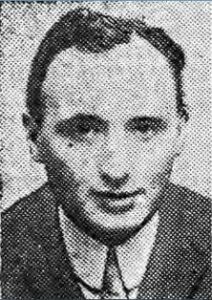
Enoch Oliver Davies, Lance Sergeant, 19042, Royal Welsh Fusiliers. Enoch was the son of John and Hannah Davies, of Maesyffin, Horeb, Llandyssul. He served on the staff of Tumble Council School prior to enlisting at Llanelli into the 16th Battalion, Welsh Regiment. The Battalion formed part of 113 Brigade, 38th (Welsh) Division, and moved to France in December 1915, spending their first winter in the trenches near Armentieres. In June they marched south to the Somme, where they were tasked with the capture of Mametz Wood. The attack on the wood began on 7 July 1916, but met with fierce resistance. After a change in command, the Division launched a fresh assault on 10 July 1916. Enoch was killed in action at Mametz on 11 July 1916. He was 20 years old, and has no known grave, and so he is remembered on the Thiepval Memorial, France.
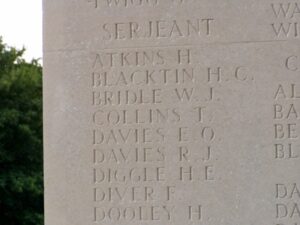
John Davies, Private, 29566, South Wales Borderers. John was born on 24 July 1895, the son of Mrs. Hannah Davies, of 3, Marble Terrace, Llandyssul. He enlisted at Brecon into the 5th Battalion, South Wales Borderers, which were attached to 58 Brigade, 19th (Western) Division. The Division moved to France in July 1915 and fought at the Battle of Loos, then moved to the Somme, where they took part in the second wave of the attack on Ovillers-La Boiselle, capturing the village at heavy cost, and fought through the Somme Battles of Pozieres and the Ancre in 1916. They then moved North to Ypres, taking part in the Battle of Messines, and fought on the Menin Road and at Polygon Wood, before moving up to Broodseinde, Poelcappelle and Passchendaele Village itself. In 1918 they were caught up in the German Spring Offensive near St. Quentin, where they suffered terrible casualties, and fought at the Battle of Bapaume. They moved to Ypres, but were caught up in the German attack at Messines, and at Bailleul, and Kemmel. After suffering terribly again, they moved South to the quieter French sector to rebuild, but were caught up in the German offensive on the Aisne. John was wounded during the Battle of the Aisne, and died of wounds on 12 June 1918. He was 22 years old, and is buried at Sezanne Communal Cemetery, France.
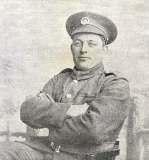
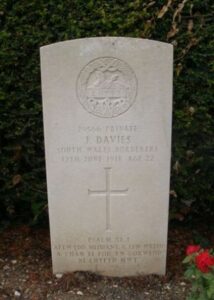
John William Davies, Pioneer, 317070, Royal Engineers. John was the son of David and Rachel Davies, of The Post Office, Felinfach. He had been born in Llanfihangel, and resided in Llandyssul prior to enlisting into the Royal Engineers at Lampeter. John was posted to the 35th Division Signal Company, which had moved to France in January 1916. They saw their first action during the Somme Offensive at the Battle of Albert. After a period of reorganisation they followed the German withdrawal to the Hindenburg Line in March 1917, and later in the year fought at the Battle of Passchendaele. Early in 1918 the Division were stationed in the area around Bapaume, and were caught there by the German Spring Offensive which was launched there on 21 March 1918. John was killed in action just days later, on 25 March 1918, aged 30. He has no known grave, and so is remembered on the Pozieres Memorial, France.
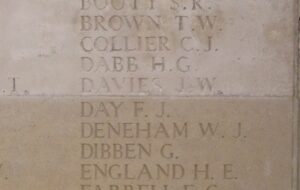
Llewellyn Davies, Private, 23135, Kings Own Yorkshire Light Infantry. Llewellyn was born in Corwen, Merioneth, the Brother of Mr. Hywel Davies, of Garthiaen, Llandrillo, Merionethshire. Llewellyn was a banker, and resided at the London County and Midland Bank, Llandyssul. He enlisted at Carmarthen into the 7th Dragoons, but later transferred to the 6th Battalion, King’s Own Yorkshire Light Infantry, which was attached to 43 Brigade, 14th (Light) Division. On 21 May 1915 they landed at Boulogne, and moved to positions east of Ypres. Here they gained the dubious distinction of being the first troops to have been attacked by the new German Flamethrower, at the Action of Hooge, and also fought at Bellewaarde. In June, 1916 they moved south and fought at the Somme Offensive, at the Battle of Delville Wood and the Battle of Flers-Courcelette, where Llewellyn was killed in action on 15 September 1916. He was 24 years old, and has no known grave, and so he is remembered on the Thiepval Memorial, France.
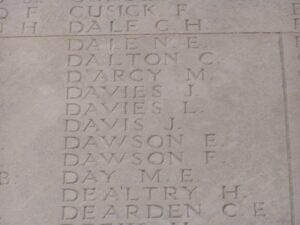
Thomas Davies, Private, 1446, Welsh Guards. Thomas was the son of John and Mary Davies, of Rhydgalfe, Llandyssul. He enlisted at Aberystwyth into the 1st Battalion, Welsh Guards, which had been formed by Royal Warrant of 26 February 1915. They landed at Havre on 8 August 1915, where they were attached to 3 Guards Brigade, Guards Division, and saw their first action at the Battle of Loos the following month. Thomas was killed in action at Loos on 27 September 1915. He was 23 years old, and has no known grave, and so is remembered on the Loos Memorial, France.
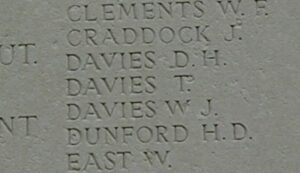
Thomas Davies, Sapper, 223291, Royal Engineers. Thomas was the son of Mrs. Elizabeth Evans, of Penbane Velindre, and the Husband of Hannah Davies, of Glyncaled, Pentrecourt, Llandyssul. Thomas enlisted at Llandyssul into the Royal Engineers, and was posted to their 411th Field Company. Thomas was stationed at the Curragh in Ireland in 1917, where he sadly died of sickness on 20 May 1917. He was 27 years old, and was brought home for burial at Llangeller (St. Celer) Churchyard.
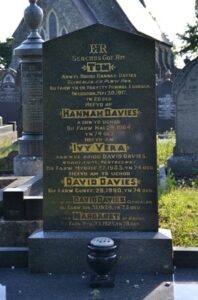
William Davies, Sapper, 121295, Royal Engineers. William was the son of William and Mary Davies, of Maesllyn, Llandyssul, and the Husband of Mary Davies, of 5, Charles Street, Llandyssul. He enlisted at Carmarthen into the Royal Engineers, and was posted to their Base at Chatham. William died on 10 December 1915, at Chatham. He was 49 years old, and is buried at Fort Pitt Military Cemetery, Kent.
Benjamin Thomas Evans, Private, 13621, Somerset Light Infantry. Benjamin was the son of Benjamin and Eleanor Evans, of Llandyssul. He resided at Brynarfer, Cardiganshire prior to the war, and enlisted at Tonypandy into the 7th Battalion, Somerset Light Infantry. The battalion moved to France on 24 July 1915, attached to 61 Brigade, 20th (Light) Division, and moved to the Fleurbaix Sector for trench familiarisation and training. When the Battle of Loos was launched on 25 September 1915, the Division fought a diversionary attack towards Fromelles. Later that year they moved north, and fought at the Battle of Mount Sorrel alongside the Canadian Corps. They then fought through the Somme Offensive. Benjamin was killed during the Battle of Delville Wood, on 3 September 1916. He is commemorated on the Thiepval Memorial, France. Benjamin is not commemorated at Llandyssul.
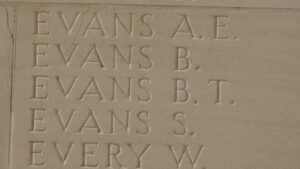
Enoch Stanley Evans, Sapper, 147701, Royal Engineers. Enoch was the son of John and Elizabeth Evans, of Moehedog-Isaf, Pontshaen, Llandyssul. He enlisted at Ferndale into the Devonshire Regiment. Enoch must have worked as a miner in Ferndale, as he was transferred to the 253rd Tunnelling Company, Royal Engineers. Enoch was wounded around the time of the Battle of Loos, and died of wounds on 21 January 1916. He was 29 years old, and is buried at Chocques Military Cemetery, France.
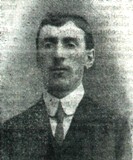
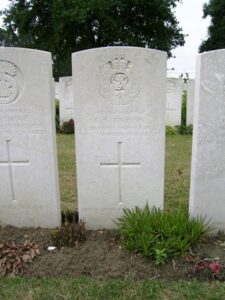
James Evans, Private, 14519, Machine Gun Corps. James was the son of Thomas and Jane Evans, of 2 Lewis Street, Llandyssul. He enlisted at Llandyssul into the Welsh regiment, but later transferred to the Machine Gun Corps, being posted to their 53rd Company, which was attached to the 18th (Eastern) Division. The Division landed at Boulogne on 25 May 1915 and didn’t see their first major battle until taking part in the Battle of the Somme in 1916. They fought at the Battle of Albert, and at the Battle of Bazentin Ridge, where James was killed in action on 19 July 1916. He was 24 years old, and has no known grave, and so he is remembered on the Thiepval Memorial, France.
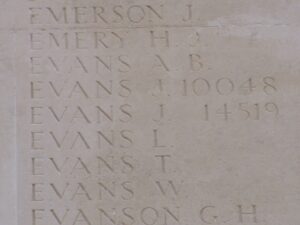
Reginald Jenkins Evans, Ordinary Seaman, Z/3826, Royal Navy. Reginald was born on 22 September 1898, the son of William and Sarah Evans, of Fair View, Llandyssul. He served in the Royal Navy, aboard HMS Vanguard, which was attached to the Grand Fleet stationed at Scapa Flow. On 9 July 1917 a giant explosion tore through the Vanguard while she was at anchor at Scapa Flow. Reginald was killed in action during the explosion that day. He was just 18 years old, and as he has no known grave he is remembered on the Plymouth Naval Memorial, Devon.
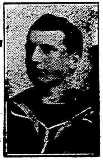
Tom Evans, Private, 53676, Welsh Regiment. Tom was the son of Daniel and Catherine Evans, of the Porth Hotel, Llandyssul. He resided at Glanteifi prior to enlisting at Llanelli into the Pembroke Yeomanry. He later transferred into the 2nd Battalion, Welsh Regiment, which was attached to 3 Brigade, 1st Division. The Division had been one of the first to arrive in France, fighting at the Battle of Mons, and taking part in the retreat to the Marne, where the Germans were stopped. They then fought at the Aisne, and at Chivy, before being moved North to Ypres. Here they fought at the First Battle of Ypres, where they again stopped the German Offensive, before wintering in Flanders. The following year saw them in action again at the Battle of Aubers, before moving South to Loos, where they fought during the Battle of Loos, and the action at the Hohenzollern redoubt. Again they were required for a major offensive, moving South to the Somme, where they fought during the opening of the Somme Offensive at the Battle of Albert, then at Bazentin, Pozieres, Flers-Courcelette and Morval. Tom was wounded on the Somme, after the Battle had been officially closed down, and sadly died of wounds on 29 December 1916, aged 30. He is buried at St. Sever Cemetery Extension, Rouen, France.
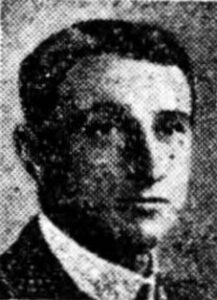
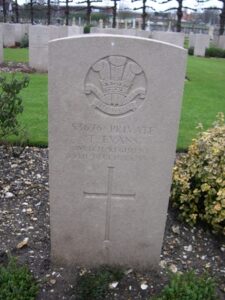
Stanley Hancock, Private, 90589, Machine Gun Corps. Stanley was the son of Harriet Hancock, of Taunton. He resided in Glandwr, Llandyssul prior to the Great War, where he worked for the Jenkins family. He enlisted at Brecon into the South Wales Borderers, but later transferred into the 197th Company, Machine Gun Corps, who were attached to the 58th (2/1st London) Division. The Division moved to France during January 1917 and followed the German withdrawal to the Hindenburg Line in March 1917. They fought at Bullecourt during May 1917 before moving north to take part in the Battle of Third Ypres. Stanley was killed in action during the Second Battle of Passchendaele on 9 November 1917, aged 21, and is buried at Coxyde Military Cemetery, Belgium.
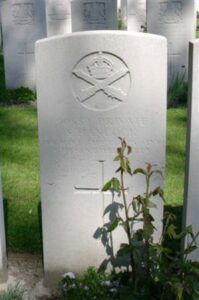
Thomas Henry Holloway, Bombardier, 138997, Royal Garrison Artillery. Thomas was born in Llandyssul, the son of Henry and Rhoda Holloway. By 1901 the family had moved to Cardiff, and by 1911 to Hereford. Thomas enlisted at Hereford into the 298th Siege Battery, Royal Garrison Artillery. Nothing much is known of Thomas, except that he was killed in action during the Battle of Passchendaele, on 10 August, 1917. His grave could not be identified after the war, and so he is remembered on the Ypres (Menin Gate) Memorial, Belgium. Thomas is not commemorated at Llandyssul.
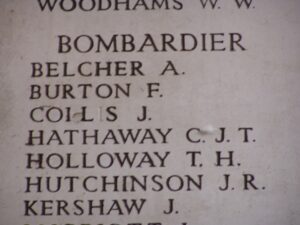
Daniel Jones, Private, 39317, South Wales Borderers. Daniel was the son of John and Hannah Jones, of Castle Howell Arms, Llandyssul. He enlisted at Newport into the Monmouth Regiment, but later transferred into the 2nd Battalion, South Wales Borderers. At the outbreak of war the Battalion were on garrison duty in China. They fought an action here against German troops stationed on Tsingtao, before being rushed back to England, where they joined 87 Brigade, 29th Division. The Division moved to Gallipoli via Egypt, landing on 25 April 1915. They remained here until evacuation to Egypt on 11 January 1916, and then moved to the Western Front on 15 March. The Division took part in its first major action in France during the 1916 Somme Offensive, and fought at the Battles of Albert and Le Transloy, suffering heavy casualties. Daniel was killed in action at the Battle of Le Transloy, on 21 October 1916. He was just 20 years old, and as his grave could not be identified after the war, he is remembered on the Thiepval Memorial, France.
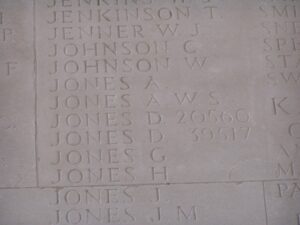
David Jones, Guardsman, 22441, Grenadier Guards. David was born at Cwm Gilfachwen, Llandyssul, the son of John and Anne Jones. He enlisted at Bargoed into the 1st Battalion, Grenadier Guards, who moved to France in September, 1914 attached to 20 Brigade, 7th Division. The Division was formed during September, 1914 and landed at Zeebrugge on 6 October 1914. The City was already falling however, and so the Division was moved to Ypres, where they became the first British Division to hold the city. They fought during the First Battle of Ypres, and helped stop the German advance through Belgium, and in March, 1917 fought at the Battle of Neuve Chapelle. During May they fought at the Battle of Aubers Ridge, and at Festubert, before the Grenadiers were transferred to 3 Guards Brigade, Guards Division on 4 August 1915. They then fought through the Battle of Loos from September onwards, and then moved to Calais in 1916 to rest. In May the Division moved to Ypres, where David was killed in action on 8 May 1916, aged 21. He is buried in Ypres Reservoir Cemetery, Belgium.
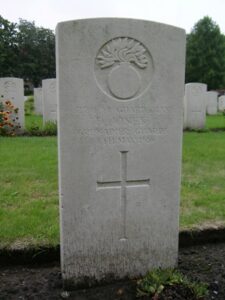
David Jones, Gunner, 262126, Royal Field Artillery. David was born on 24 January 1899, the son of David and Jane Jones, of 176, Fenton Road, Hanley, Stoke-on-Trent. He resided at Laura House, Pontwelly prior to the war, and worked as a waggoner. David enlisted on 22 January 1917, and served in the 5th Reserve Brigade, Royal Field Artillery, on home service. He died of tuberculosis on 28 February 1919, aged just 20, and is buried at Stoke-On-Trent (Hanley) Cemetery, Staffordshire.
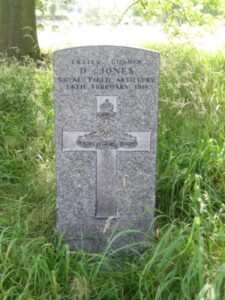
David Tom Jones, Private, 267137, Welsh Regiment. David was the son of Elias and Mary Jones, of Horeb Cottage, Aberythan, Llandyssul. He served in the 6th Battalion, Welsh Regiment, which had been attached to the 1st Division as Pioneers. Little else is known of him, but he died of tubercular meningitis at Cardiff on 23 June 1919, aged 21. He is buried in Capelcwm Unitarian Chapelyard.
George Jones, Driver, T/2055, Army Service Corps. George was the son of David and Ann Jones, of South Lodge Alltyrodin. He worked as a collier prior to the war and lived with his wife Mary Ann Jones at 22, Parry Street, Ton Pentre. He enlisted at Treorchy on 15 April 1915 into the Army Service Corps, and was attached to the 53rd (Welsh) Division, joining the division at Gallipoli. He took ill soon after reaching the front and was hospitalised at Malta, where he was diagnosed as suffering from pulmonary tuberculosis. He returned to Britain for sanatorium treatment and was discharged from the army as medically unfit on 25 August 1916. The memorial states that George was gas poisoned in 1918, but it was his tuberculosis that brought a premature end to his life when he died on 26 February 1919, aged 32. George is not commemorated by the CWGC, but I have recently submitted his case to the CWGC in the attempt to get him officially commemorated as a casualty of war.
John Jones, Private, 201530, Welsh Regiment. John was the son of Evan and Hannah Jones, of Ffoshelyg, Llandyssul. He enlisted at Newport into the 1/4th Battalion, Welsh Regiment, which formed part of the South Wales Brigade. On 17 April 1915 the Battalion was attached to 159 Brigade, 53rd (Welsh) Division, and in July that year sailed with the Division to Alexandria, en route to Gallipoli. On 9 August 1915 the Division landed on Gallipoli, at saw action almost straight away. They remained here until evacuation in December 1915 after suffering heavy casualties, and moved to Egypt, taking up positions on the Suez Canal Defences. In 1916 the Division fought in a few minor skirmishes with the Turks, and Arabs loyal to the Turks, and in 1917 an offensive was launched into Palestine. John was killed in action here, during the First Battle of Gaza, on 26 March 1917. He was 23 years old and is remembered on the Jerusalem Memorial, Israel.
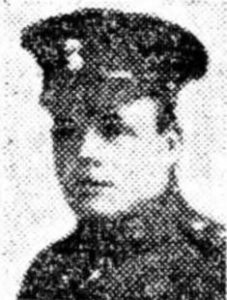
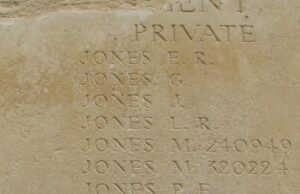
John Benjamin Jones, Private, 3359, Royal Fusiliers. John was the son of Thomas and Elizabeth Jones, of Llwyn Cottage, Rhydowen, Llandyssul. He lived in Marylebone prior to the war, and enlisted at London into the 9th Battalion, Royal Fusiliers. They formed part of 36 Brigade, 12th (Eastern) Division, and landed at Boulogne on 31 May 1915, taking over the line at Ploegsteert Wood. They then moved south and fought in the Battle of Loos, and remained there until March 1916. By June 1916 they were in position at the Somme, and attacked Ovillers on 2 July 1916. They fought at Pozieres and Le Transloy before being moved to the Arras area, where they fought in the March 1917 Battle of Arras. John was killed in action here, during the Battle of the Scarpe, on 9 April 1917. He was 22 years old, and is buried at Ste. Catherine British Cemetery, France.
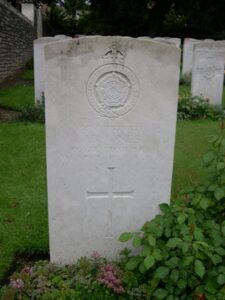
John Owen Jones, Private, 125618, Machine Gun Corps. John was the son of William John Jones and Hannah Jones, of Gwylfa, Llandyssul. He enlisted at Llanelli into the King’s Liverpool Regiment, but later transferred into the 20th Battalion, Machine Gun Corps. This Battalion was attached to the 20th (Light) Division, which had moved to France during July 1915 and assembled at St. Omer, before moving to positions near Fleurbaix. When the Battle of Loos was launched on 25 September 1915 the Division fought a diversionary attack towards Fromelles. Later that year they moved north, and fought at the Battle of Mount Sorrel alongside the Canadian Corps. Over the winter of 1915/16, the Division remained in positions south of Ypres, and fought at the Battle of Mount Sorrel in June, alongside the Canadian Corps. They then fought through the Somme Offensive, at the Battles of Delville Wood, Guillemont, Flers-Courcelette, Morval and Le Transloy, and took part in the advance to the Hindenburg Line in March 1917. Later that year they fought at Third Ypres, at the Battles of Langemarck, the Menin Road, and Polygon Wood, before moving south in November, to take part in the Battle of Cambrai. They remained in the area between Cambrai and St. Quentin over the winter of 1917/18 and were attacked there by the German Spring Offensive of 21 March 1918. They then fought in the retreat at the Battle of the Somme Crossings and the Battle of Rosieres. Due to the terrible amount of casualties suffered by the Division in March and April 1918 they were moved to positions south of Amiens to rebuild. John was wounded sometime after, as he died of wounds on 9 July 1918. He was just 19 years old, and is buried at Aubigny Communal Cemetery Extension, France.
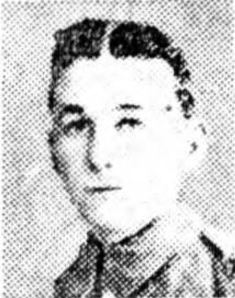
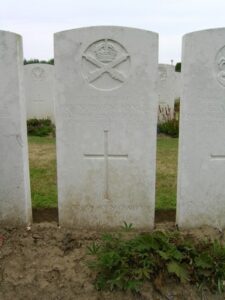
John Rees Jones, Private, 29779, Kings Shropshire Light Infantry. John was born at Llanfairorllwyn in 1881, the son of David and Hannah Jones, of Blaenmachnog, Horeb. He enlisted at Llandyssul into the Welsh Regiment. He later transferred into the 10th Battalion, King’s Shropshire Light Infantry, which was attached to 231 Brigade, 74th (Yeomanry) Division. The Division had formed in Egypt in January 1917 and had fought through the Palestinian Campaign, at the Battles of Gaza and the Battle and capture of Jerusalem. Due to the terrible casualties suffered by the British on the Western Front in March and April 1918 the Division was recalled to the Western Front, and arrived at Marseilles during May, 1918. They then fought at the Second Battle of Bapaume during the great offensive, and fought in Flanders where John was killed in action on 7 September 1918, aged 37. He is buried at Villers-Faucon Communal Cemetery Extension, France.
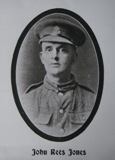
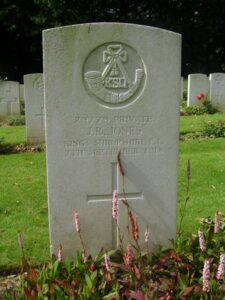
John Thomas Wilson Jones, Private, 1909, Welsh Guards. John was the son of David and Elizabeth Jones, of Merville, Llandyssul. He enlisted at Cardiff into the Royal Army Service Corps, and later transferred into the 1st Battalion, Welsh Guards, who had been raised after the Royal Warrant on 26 February 1915. After being formed, they became part of 3 Guards Brigade, Guards Division, which was formed in France in August, 1915. Their first taste of battle was at the Battle of Loos, before being brought south to the Somme in 1916. During the Somme Offensive the Division fought at the Battles of Flers-Courcelette, and Morval and were then moved to Calais to rest and rebuild. They then followed the German withdrawal to the Hindenburg Line in March 1917 before moving to positions around Ypres to prepare for the Offensive of Third Ypres. John was wounded during the preparation for the battle, and died of wounds on 29 July 1917, aged 29. He is buried at Mendinghem Military Cemetery, Belgium.
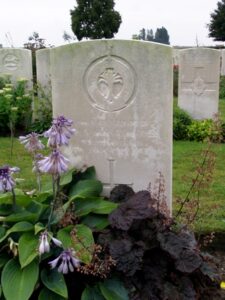
Thomas William Jones, Private, 24230, Welsh Regiment. Thomas was born in Llandyssul, the son of William J. Jones, later of 19, Brynheulog Terrace, Tylorstown, Glamorgan. He enlisted at Llandyssul into the 16th Battalion, Welsh Regiment, which were attached to 11 Brigade, 38th (Welsh) Division. The Division had landed in France during December 1915 and spent their first winter in the trenches near Armentieres, which is where Thomas was wounded. He died of wounds on 1 April 1916, aged just 19, and is buried at Guards Cemetery, Windy Corner, Cuinchy, France.
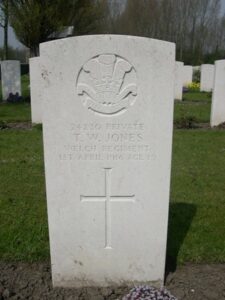
William Robert Jones, Private, 341, East Surrey Regiment. William was born at Newington, Surrey, the son of David and Anne Jones. The family later resided at South Lodge, Alltrodin, Llandyssil. William was an army reservist when he enlisted into the 9th Battalion, East Surrey regiment, which was attached to 72 Brigade, 24th Division. They moved to France during August, 1915 and marched to positions near Loos, where they took up reserve positions for the main Battle of Loos. The Division were sent into battle on 26 September 1915 at Loos and suffered terrible casualties due to not being properly trained for battle, and were pulled from the line until the following year. In 1916 they took part in the Battle of the Somme, and fought at Delville Wood and Guillemont, before moving north of Arras in early 1917. In April and May 1917 they fought at the Battle of Vimy, alongside the Canadian Corps, and in June they moved to positions south of Ypres, where they fought during the Battle of Messines. After the successful capture of Messines Ridge, the Division moved further north, and fought at the Battles of Pilckem and Langemarck during Third Ypres. The Division then moved to positions north of St. Quentin over the winter of 1917/18, which is where William died of sickness on 23 February 1918. He was 45 years old, and is buried at Tincourt New British Cemetery, France.
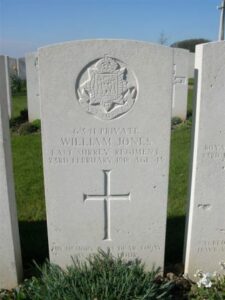
Harry Knight, Private, 38989, Welsh Regiment. Harry was born in Somerset. He resided at Farmyard, Llandyssul prior to the war, and enlisted at Newcastle Emlyn into the 2nd Battalion, Welsh Regiment. The Battalion formed part of 3 Brigade, 1st Division, which had had been one of the first to arrive in France, fighting at the Battle of Mons, and taking part in the retreat to the Marne, where the Germans were stopped. They then fought at the Aisne, and at Chivy, before being moved North to Ypres. Here they fought at the First Battle of Ypres, where they again stopped the German Offensive, before wintering in Flanders. The following year saw them in action again at the Battle of Aubers, before moving South to Loos, where they fought during the Battle of Loos, and the action at the Hohenzollern redoubt. Again they were required for a major offensive, moving South to the Somme, where they fought during the opening of the Somme Offensive at the Battle of Albert, then at Bazentin, Pozieres, Flers-Courcelette and Morval. They followed the German retreat to the Hindenburg Line in early 1917, and were then briefed for an operation on the Flanders Coast, and moved there during the Summer of 1917. While training on the coast, the Battle of Third Ypres had stalled in the mire, and the Division were recalled to Ypres, where they fought at the Second Battle of Passchendaele. After spending another Winter in Flanders, they were near Estaires when the German Spring Offensive caught them, fighting through the Battles of Estaires, Hazebrouck, and Bethune before being moved South again to Arras, fighting at the Battle of Drocourt-Queant, and at the Battle of Épehy, after the tide had been turned in the favour of the Allies. The Division pushed on towards the St. Quentin Canal. Harry was killed in action during the advance on the Hindenburg Line on 15 September 1918, and is buried at Vadencourt British Cemetery, Maissemy, France.
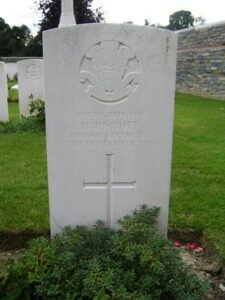
David Jacob Lewis, Second Lieutenant, Royal Fusiliers. David was the son of David and Anne Lewis, of Bronheulog, Llandyssul. He enlisted into the 2nd Battalion, Royal Fusiliers, which were attached to 86 Brigade, 29th Division. The Division moved to Gallipoli via Egypt, landing on 25 April 1915. They remained here until evacuation to Egypt on 11 January 1916 and then moved to the Western Front on 15 March. The Division took part in its first major action in France during the 1916 Somme Offensive, and fought at the Battles of Albert and Le Transloy, suffering heavy casualties. David was killed in action on the Ancre during the winter of 1916/17, on 28 February 1917, aged only 22. His body was lost on the battlefield, and so he is remembered on the Thiepval Memorial, France.
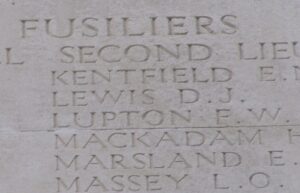
John Lewis, Private, 22252, Welsh Regiment. John was the son of Thomas and Mary Lewis, of Penbryn Horeb, Llandyssul. He enlisted at Cardiff into the 13th Battalion, Welsh Regiment, which was attached to 114 Brigade, 38th (Welsh) Division. The Division landed in France during December 1915 and had spent their first winter in the trenches near Armentieres. John was wounded in the trenches on 1 March 1916, and died of wounds on 3 March. He was 25 years old, and is buried at Merville Communal Cemetery, France.
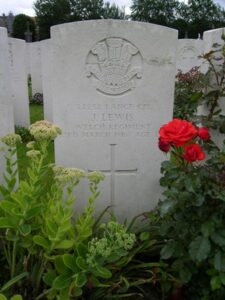
David Lloyd, Private, 29556, South Wales Borderers. David was the son of Henry and Hannah Lloyd, of Gilfachddafydd, Llandyssul. He enlisted at Brecon into the 2nd Battalion, South Wales Borderers, who were attached to 87 Brigade, 29th Division. The Division moved to Gallipoli via Egypt, landing on 25 April 1915. They remained here until evacuation to Egypt on 11 January 1916 and then moved to the Western Front on 15 March. The Division took part in its first major action in France during the 1916 Somme Offensive, and fought at the Battles of Albert and Le Transloy, suffering heavy casualties. In the Spring of 1917 they fought at the Battle of the Scarpe, which was part of the Arras Offensive, and then moved further north to Ypres. Here they fought at the Battle of Langemarck, and then at the Battles of the Menin Road, Polygon Wood, Broodseinde and Poelcappelle, before moving to Cambrai. Here they fought at the Battle of Cambrai in November and December 1917 before moving back to Flanders early in 1918. The German Spring Offensive hit the British on the Somme on 21 March 1918, and hit in Flanders just weeks later. The Division fought at the desperate defensive battles of Estaires, Messines, Bailleul and Kemmel, before the war turned in favour of the Allies after a series of successes on the Somme in August. The Division then took part in the Offensive in Flanders, where David was killed in action during the Battle of Courtrai, on 15 October 1918. He was 32 years old, and is buried at Dadizeele New British Cemetery, Belgium.
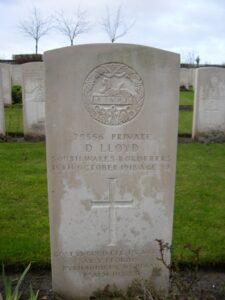
Duncan Ian Bowen Lloyd, Lieutenant, Indian Army. Duncan was born on 16 March 1886, the son of Charles and Margaret Macfie Lloyd (nee Campbell), of Waunifor, Maesycrugiau. He was educated at Oswestry Grammar School, and Clifton College before attending Sandhurst in 1905. Duncan was gazetted Second Lieutenant in 1906, and accepted a Commission into the Indian Army in 1907, seeing service in India. At the outbreak of war he was Quartermaster of the 1st Battalion, 5th Ghurkha Rifles, which had served in the Middle East before landing on Gallipoli. Duncan was placed in charge of the 1/6th Ghurkha Rifles there, but was killed in action at Damajelik Bair, during the Defence of Helles on 14 August 1915, aged 29. He was originally buried where he fell, but his grave was lost during further fighting, and today Duncan is remembered on the Helles Memorial. Duncan was Mentioned in Sir Ian Hamilton’s Despatches on 17 March 1917, for his gallant services at Gallipoli.
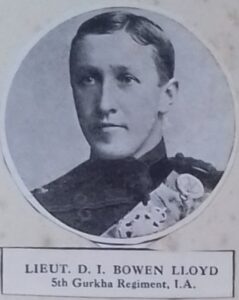
Gwion Llewellyn Bowen Lloyd, Captain, Dorsetshire Regiment. Gwion was born on 21 February 1888, the son of Charles Lloyd, and of Margaret MacFie Lloyd (nee Campbell), of Waunifor, Maesycrugiau. Gwion had been commissioned into the Dorsetshire Regiment, and served with their 5th Battalion, attached to 34 Brigade, 11th (Northern) Division. The Division came into existence of Army Order No.324, issued on 21 August 1914, authorising the formation of the six new Divisions of K1. It was formed of volunteers, under the care of the War Office. Initially without equipment or arms of any kind, the recruits were judged to be ready by late Spring 1915, and it was ordered to reinforce the beleaguered garrison on Gallipoli. On 1 July 1915 the Division sailed from Liverpool, landing at Alexandria, and on to Mudros, completing concentration by 28 July 1915. On 7 August 1915 they landed at Suvla Bay, Gallipoli, and fought in the Battle of Sari Bair, where Gwion was killed in action on 11 August 1915, aged 27. He has no known grave, and is commemorated on the Helles Memorial, Gallipoli, alongside his brother Duncan.

John Lewis Lloyd, Captain, Canadian Infantry. John was born on 17 October 1881, the son of Richard and Mary Elizabeth Lloyd, of Bryntawel, Llandyssul. He emigrated to Canada prior to the war, and enlisted at Victoria, British Columbia on 6 December 1915. His papers show that he had served for three years in the 3rd Volunteer Battalion, Welsh Regiment prior to emigrating, and so he was immediately commissioned into the 102nd Battalion (Central Ontario), Canadian Infantry. The Battalion formed part of 11 Brigade, 4th Canadian Division and moved to France in August 1916. They saw action during the Somme Offensive at Le Transloy, and at the Ancre, before moving to Arras, where they assaulted and captured Vimy Ridge during April 1917. In August they fought at the Battle for Hill 70 near Loos, and in October fought at Third Ypres, at the Second Battle of Passchendaele. August, 1918 saw the Canadian Corps fighting on the Somme. On 8 August 1918 a Battle took place around Villers Brettoneux, where the Allies gained a victory over the Germans that turned the war. The Canadian Corps were at their side, during the Battle of Amiens, which is where John was killed on 8 August 1918, aged 36. He is buried at Beaucourt British Cemetery, France.
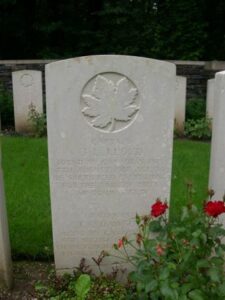
David Morgan, Private, 31896, Welsh Regiment. David was born at Pontfach, Llandyssul in 1871, and was the husband of Mary Morgan, of Pontfach, Llandyssul. He enlisted at Carmarthen into the 21st Battalion, Welsh Regiment, which was a Reserve Battalion. David had been attached to the 2nd Battalion, which was in France as part of 3 Brigade, 1st Division, but died at home of sickness on 9 April 1916. He is buried at Llandyssul (St. John) Churchyard.
John Osbourne, Able Seaman, Z/3613, Royal Navy. John was born on 9 November 1897, the son of Walter and Elizabeth Osborne, of 74, Moors Cottages, Crockenhill, Swanley Junction, Kent. He resided at Cwmmarch, Llandyssul prior to the war, and served with the Royal Navy, aboard the SS Madame Renee. John was drowned when the ship was sunk off Scarborough by a German U-Boat on 10 August 1918. He was just 19 years old, and is remembered on the Plymouth Naval Memorial, Devon.
Arthur Parker, Private, 420894, Canadian Infantry. Arthur was born on 1 May 1895, the son of Mary Parker of London, and was the husband of Fanny Parker (Later Fanny Coote, 26, Marlboro Buildings, Bath). By 1911 Arthur was residing at Pontshan Stores, Llandyssul, and had emigrated to Canada prior to the war. He enlisted at Winnipeg on 29 December 1914, and was posted to the 16th Battalion (Manitoba), Canadian Infantry, who were attached to 3 Brigade, 1st Canadian Division. The Division arrived in Britain on 14 October 1914 and moved on to France in February 1915, moving to Ypres. Here they fought at the Battle of Gravenstafel in April, and faced the first German Gas Attacks that month, saving the line at St. Julien, when the French Colonials holding the line were hit by the first poison gas attack of the war, and fled. In May they fought at the Battle of Festubert, and in June at Givenchy. In June 1916 the Canadian Corps assaulted the German positions on Mount Sorrel, which is where Arthur was killed on 13 June 1916. He was just 21 years old, and is buried at Railway Dugouts Burial Ground, Belgium.
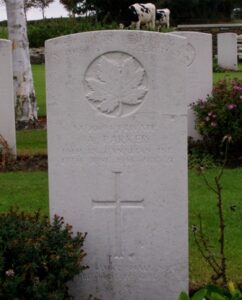
Richard Glyndwr Phillips, Lieutenant, Royal Garrison Artillery. Richard was the son of Llewellyn and Hetty Phillips, of Marblestone House, Llandyssul. He worked prior to the war as an official at the N P and U Bank of England, Ltd. (Cardiff Branch). Richard was commissioned into the Royal Garrison Artillery, and landed in France on 2 June 1917. He was posted to their F anti-aircraft Battery, which was attached to the Fourth Army. The Fourth Army were fighting in the Battle of Passchendaele, when Richard was killed in action on 27 August 1917. He was 30 years old, and is buried at Bard Cottage Cemetery, Belgium.
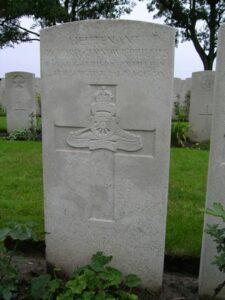
Daniel Rees, Private, 12581, Devonshire Regiment. Daniel was the son of John and Sarah Rees, of 3, Lewis Street, Pontwely, Llandyssul. He enlisted at Ferndale into the 9th Battalion, Devonshire Regiment, which was attached to 20 Brigade, 7th Division, and moved to Belgium on 6 October 1914, landing at Zeebrugge. Due to the imminent collapse of the Zeebrugge defences, the Division were moved south, and took up positions east of Ypres. Here, they fought the advancing German Army to a standstill during First Ypres, and settled down for their first winter on the Western Front. In March 1915 they fought at the Battle of Neuve Chappelle, and then in May fought at Aubers Ridge. They then fought at Givenchy, before taking part in the Battle of Loos in September. After a hard winter near Loos, they moved to the Somme in June, 1916, and fought during the Somme Offensive, at the Battles of Albert and Bazentin. They then moved towards Delville Wood, where Daniel was killed in action on 4 September 1916. He was 22 years old, and is buried at Delville Wood Cemetery, Longueval, France.
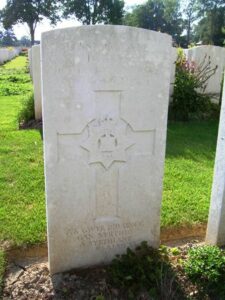
John Brinley Rees, Ordinary Seaman, Z/4541, Royal Navy. John was born at Neath on 6 March 1900, the son of John and Jane Rees. The family later resided at Derwlyn, Llysyfran, Clarbeston Road, while John worked at Lloyd’s Bank, Llandyssul prior to the war. He enlisted into the Royal Navy and served at HMS Norwood, the Royal Naval Depot at Crystal Palace. John died at Croydon of sickness on 24 May 1918 and is buried at Maenclochog (St. Mary) Churchyard.
Cyril Robinson, Lance Sergeant, 21968, Welsh Regiment. Cyril was born in Poplar, Middlesex, and prior to the war resided at Fronwen, Llandyssul. He enlisted at Llandyssul into the 2nd Battalion, Welsh Regiment, which was attached to 3 Brigade, 1st Division. The Division had been one of the first to arrive in France, fighting at the Battle of Mons, and taking part in the retreat to the Marne, where the Germans were stopped. They then fought at the Aisne, and at Chivy, before being moved North to Ypres. Here they fought at the First Battle of Ypres, where they again stopped the German Offensive, before wintering in Flanders. The following year saw them in action again at the Battle of Aubers, before moving South to Loos, where they fought during the Battle of Loos, and the action at the Hohenzollern redoubt. Again they were required for a major offensive, moving South to the Somme, where they fought during the opening of the Somme Offensive at the Battle of Albert, then at Bazentin, Pozieres, Flers-Courcelette and Morval. Cyril was wounded after the Somme battles had drawn to a close, and died of wounds on 28 December 1916, aged 21. He is buried at Dernancourt Communal Cemetery Extension, France.
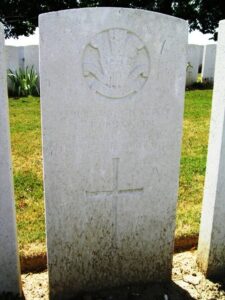
William Henry Russen, Private, 21969, Welsh Regiment. William was born in Marylebone early in 1895, the son of Eleanor Russen, and resided at Cwmmarch, Llandyssul prior to the war. He served with the 3rd Battalion, Welsh Regiment, which was a home service battalion, used for reinforcing the Welsh Battalions on the Western Front. William cut his leg during a riding accident at Carmarthen and died of lockjaw at Carmarthen Infirmary on 25 October 1915. To illustrate how many people must have died during the war from simply having cuts and wounds infected, if penicillin was available by then William would have been saved with a simple course of tablets. He was 21 years old, and is buried at Carmarthen Cemetery.
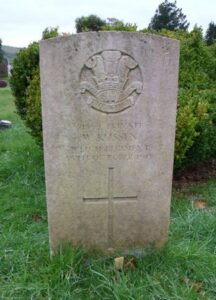
James Alexander Logan Stewart, Lieutenant, Rifle Brigade. James was born on 7 March 1893, the son of Lieut. James Logan Stewart, 7th Hussars and the Hon. Eveline Mary, of Alltrodyn, Llandyssul. He was educated at Winchester & Trinity College, Cambridge. James was commissioned into the Rifle Brigade on 2 September 1913, and was promoted to full Lieutenant on 30 November 1914, being sent to the front in December 1914, where he was posted to their 1st Battalion, was attached to 11 Brigade, 4th Division. James hadn’t been on the Western Front for long, when he found himself in charge of two Platoons at Shell Trap Farm, Wieltje, during the Battle of Frezenberg. He was reported missing on 13 May 1915, and was later notified as have been killed in action that day by the Red Cross. James was only 22 years old, and is buried at Poelcapelle British Cemetery, Belgium.
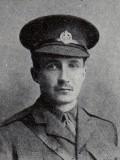
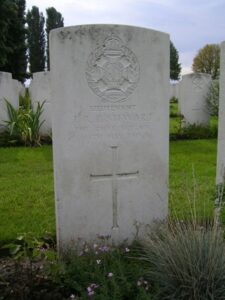
James Thomas, Private, 9053, East Surrey Regiment. James was born at Dan Coed Mawr, Llandyssul in 1876, the son of Evan and Margaret Thomas, and by 1901 was working as a miner at Senghenydd. He married Catherine Williams at Pontypridd Registry Office on 15 July 1902, and the couple lived at 14, High Street, Senghenydd. James enlisted at Senghenydd into the 3rd Battalion, East Surrey Regiment on 5 September 1914, and joined the battalion at Shoreham. He was then posted to the 9th Battalion, East Surrey Regiment which was attached to 72 Brigade, 24th Division. The Division moved to France during August 1915 and marched to positions near Loos, where it took up reserve positions. Despite its inexperience, it was sent into action at Loos on 26 September 1915, and suffered terrible casualties. It was then withdrawn from the line, and didn’t see action until the summer of 1916 when it was moved to the Somme. James was killed in action here during the Battle of Guillemont, on 16 August 1916, aged 40. He has no known grave and is commemorated on the Thiepval Memorial, France. James is not commemorated locally.
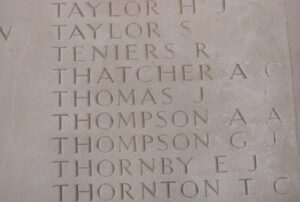
George Henry Turner, Rifleman, 897117, London Regiment. George was the son of George and Elizabeth Turner, of 6, Loxford Avenue, East Ham. George had moved to Llandyssul, and lived with his wife Annie Turner, at Llwyn Cottage, Pontshaen, Llandyssul. He returned to London to enlist at East Ham, into the Middlesex Regiment, but later transferred into the 34th Battalion, London Regiment, which was attached to 49 Brigade, 16th (Irish) Division. In December 1915 the Division moved to France, and saw its first major action during the 1916 Somme Offensive, at the Battles of Guillemont and Ginchy. They then moved to positions south of Ypres, and fought in the 1917 Battle of Messines, and then at Langemarck during Third Ypres. In 1918 they were in positions near St. Quentin when the German Spring Offensive was launched on 21 March 1918, and fought at the Battles of St. Quentin and Rosieres. On 18 June 1918 after suffering heavy casualties, the Division moved to England to rebuild, and on 1 August 1918 returned to France. They then fought in the great offensive which was to bring an end to the Great War, and George was wounded during the Final Advance in Artois. He died of wounds on 31 October 1918, aged 32, and was buried at Don Communal Cemetery, Annoeullin, France.
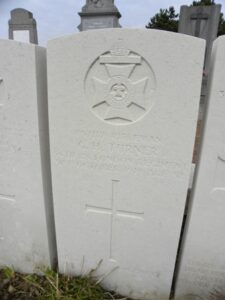
Albert Edward Young, Private, 1658, Welsh Guards. Albert was born in Llannon, the son of Police Constable Thomas Edward Young and Anne Young. The family resided in the Police Station, Llandyssul prior to 1911, and Albert began a watchmaker’s apprenticeship. He enlisted at Carmarthen into the 1st Battalion, Welsh Guards, which had been formed by Royal Warrant of 26 February 1915. They landed at Havre on 8 August 1915, where they were attached to 3 Guards Brigade, Guards Division. They saw their first action at the Battle of Loos the following month, and suffered terrible casualties before moving north to Ypres, where they were to remain until moving south to the Somme in July 1916 to take part in the Somme Offensive. Albert was wounded just before the Guards Division made their move to the Somme, on 1 July 1916. He was brought to the Base Hospital at Wimereux where he died of wounds on 10 July 1917. He was 21 years old, and is buried in Wimereux Communal Cemetery, France.
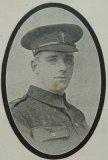
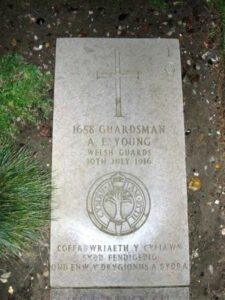
World War Two, 1939-1945
Joseph Davies Ashdown, Serjeant, 2734502, Welsh Guards. Joseph was the son of Mr and Mrs David Joseph Ashdown, of Swansea. He married Margaret Jane Howells, of Llandyssul just prior to embarking for France with the 1st Battalion, Welsh Guards. The Welsh Guards moved to the city of Arras, and from 17 to 24 May 194 staunchly defended the city before starting the withdrawal to Dunkirk. Joseph was killed in Arras on 20 May 1940, aged 23, and is commemorated on the Dunkirk Memorial, France. Joseph is not commemorated at Llandyssul.
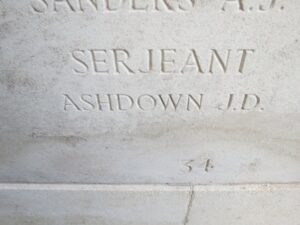
Leonard Frederick Ball, Radio Officer, Merchant Navy. Leonard was the son of Frederick Henry and Rachel Ball of Llandyssul, and the husband of Beryl Ball, of Newcastle Emlyn. He served in the Merchant Navy, aboard the S.S. Shahzada (London), a Cargo Steamer that had been built in 1942. On 9 July 1944 she was en-route from Mormugao for Aden, carrying a cargo of 5,000 tons of groundnuts, when she was torpedoed and sunk by the U-196. Forty six of her crew were lost, including Leonard, who was 33 years old. He is remembered alongside his crewmates on the Tower Hill Memorial, London. Leonard is also commemorated on the Newcastle Emlyn War Memorial. Many thanks to his son Clive for supplying the photos.
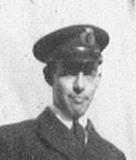
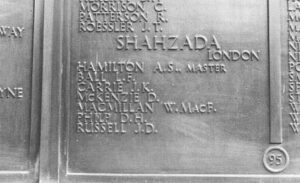
Elvin Davies, Private, 4200974, South Staffordshire Regiment. Elvin was the son of John and Ann Davies, of Velindre, Llandyssul. He served with the 2/6th Battalion, South Staffordshire regiment, which was attached to 177 Brigade, 59th (Staffordshire) Division. The Division had landed in Normandy in early July, and moved to positions around Caen, where they were to take part in Operation Charnwood, the capture of Caen. Elvin was killed in action during the initial attack on 8 July 1944. He was 24 years old and is buried at Cambes-en-Plaine War Cemetery, France. Elvin is not commemorated at Llandyssul.
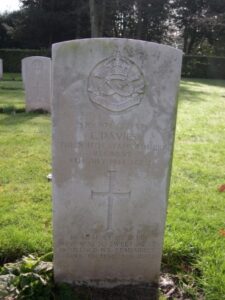
Owen Geraint Davies, Radio Officer, Royal Air Force Transport Command. Owen was the son of John Alaska Davies and Annie Mary Davies, of Sychpant, Llandysul. He served in the Royal Air Force Transport Command, and was sadly killed on a ferry flight over Canada on 8 November 1943. He was 19 years old, and is remembered on the Ottawa Memorial, Canada.
David Evans, Fusilier, 4202702, Royal Welch Fusiliers. David was the son of Thomas and Anne Evans, and the husband of Hannah M. Evans, of Llandyssul. He served with the 4th Battalion, Royal Welch Fusiliers, which was attached to 158 Brigade, 53rd (Welsh) Division. The division spent much of the war on home service, before landing in Normandy at the end of June 1944. It then took part in the break-out from the Normandy beach-head. On the night of 16 July, 158 Brigade began its famous assault on the strongly defended town of Evrecy. David was killed the following day, on 17 July 1944, aged 31, and is buried at Banneville-La-Campagne War Cemetery, France. David is not commemorated at Llandyssul.
John Evans, Leading Aircraftman, 982547, Royal Air Force Volunteer Reserve. John was the son of Sarah Evans, Kings Head Hotel, Llandyssul. He was stationed at RAF Singapore at the beginning of World War Two, and was sadly killed during the Japanese Invasion of the Island on 14 February 1942. John has no known grave, and so is remembered on the Singapore Memorial.
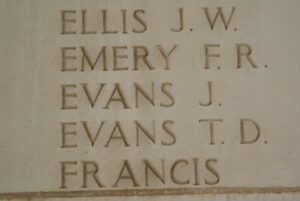
Benjamin Emlyn Griffiths, Able Seaman, Australian Merchant Navy. Benjamin was born at New Quay in 1899, the son of John and Anne Griffiths. The family later moved to Llandyssul, while Benjamin had emigrated to Boarke, Victoria, Australia several years prior to the war. He served with the Australian Merchant Navy, aboard the S.S. Kowarra, a Melbourne registered steamship. On 24 April 1943 Kowarra was torpedoed and sunk by a Japanese submarine off Queensland. Benjamin was 43 years old when he died that day, and is commemorated on the Sydney Memorial, Australia. Benjamin is not commemorated at Llandyssul.
Benjamin Frederick Jones, Mess Room Boy, Merchant Navy. Benjamin was from Gwylfa, Llandyssul, and served in the Merchant Navy, aboard the S.S. Coast Wings (London). She was an old Dutch cargo ship, that had been launched in 1916, and on 27 September 1940, was part of Convoy OG-43 when she was torpedoed and sank by the U-46. Benjamin was killed in the sinking of the ship. He was 24 years old, and is remembered on the Tower Hill Memorial, London.
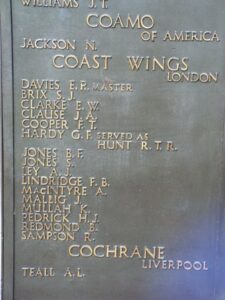
Gwilym Arthur Jones, Sapper, 1873012, Royal Engineers. Gwilym resided at Glaspant, Llandyssul, and was the son of Ben and Mary Anne Jones, of Tregroes, Cardiganshire. He served prior to the war with the Royal Engineers, with the 59th Field Company, and moved to France with the BEF in 1939. Gwilym was killed during the retreat through Belgium to the evacuation beaches at Dunkirk, on 31 May 1940. He was 22 years old, and is buried at De Panne Communal Cemetery, Belgium.
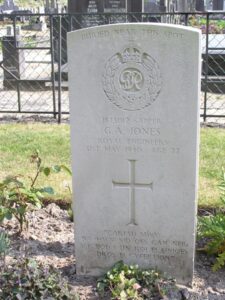
John Owen Jones, Master, Merchant Navy. John was the son of Captain John Jones, Merchant Navy and Jane Jones, and the husband of Muriel Stephen Jones, of Llandyssul. John served in the Merchant Navy, and died of sickness at Buenos Aires, Argentina, on 16 December 1939. He was 37 years old, and is buried at Cementario Brittanico, Buenos Aires. John is not commemorated at Llandyssul.
Teifi Jones, Aircraftman 1st Class, 1123171, Royal Air Force Volunteer Reserve. Teifi was the son of John and Ellen Jones, of Cwmgilfachwen, Llandyssul. He served in the RAFVR, and had been captured at some time by the Japanese in the Far East, and given the POW No. 2659. Teifi was taken to Sandakan Number 2 Camp, and the British were later moved from this camp to the Number 1 Camp about 15 April 1945. Survivors were then moved back to a wired section of Number 2 Camp on 29 May 1945. Teifi is recorded as having died of Malaria while a POW, on 21 July 1945. There is evidence of a large number of POW’s murdered by the Japanese on the ‘Sandakan Death Marches’ as they were killed, and their death’s attributed by the Japanese to disease. Teifi was 23 years old, and is remembered on the Singapore Memorial.
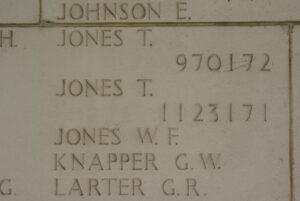
Thomas David Jones, Rifleman, 3245289, Cameronians (Scottish Rifles). Thomas was from Typoeth, Llandyssul, and served with the 1st Battalion, Cameronians. The Battalion were attached to the 48th Indian Infantry Brigade, 17th Indian Infantry Division in Burma. Thomas was killed in action during the Japanese invasion of Burma, on 18 April 1942. He was 24 years old, and is remembered on the Rangoon Memorial, Myanmar. The photograph has been kindly supplied by Tony Beck and shows his name just as D Jones.
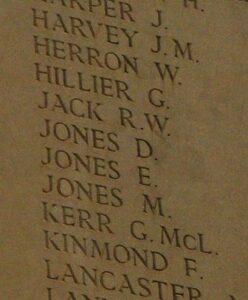
Alcwyn Lloyd Thomas, Supply Assistant, D/MX67820, Royal Navy. Alcwyn was the son of Thomas Enoch and Anne Thomas, of Thespian, Llandyssul, and served in the Royal Navy, aboard HMS Charybdis, a Dido-Class Cruiser, that had been launched in 1940, and commissioned a year later. She served in the Mediterranean during the Malta Convoys, and then covered the Allied Landings on North Africa and Salerno, before moving to the Atlantic in 1943. In October, she was part of a force that had been sent to intercept a German merchant ship, which was carrying important war materials to Germany, when she was torpedoed and sunk by a German Torpedo Boat on 23 October 1943. Alcwyn was killed in the loss of the ship that day, aged 31, and is remembered on the Plymouth Naval Memorial, Devon.
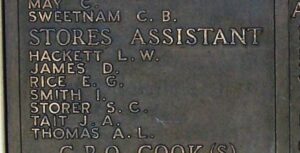
Owen Goronwy Thomas, Leading Writer, D/MX105408, Royal Navy. Owen was born in Loughor in 1908, the son of Thomas and Elizabeth Thomas. His parents moved to Martley, Llandyssul at some time after the war. Owen married Doris Cordelia Morris of Llanelly in 1936. He enlisted into the Royal Navy and served aboard the Dido Class destroyer HMS Charybdis. She was sent to sea in the English Channel on 23 October 1943 as part of a number of vessels to intercept the German supply ship Munsterland. Charybdis was attacked and sunk by a squadron of German torpedo boats that day, with the loss of over 400 men. Owen was 35 years old, and is remembered on the Plymouth Naval Memorial, Devon.
